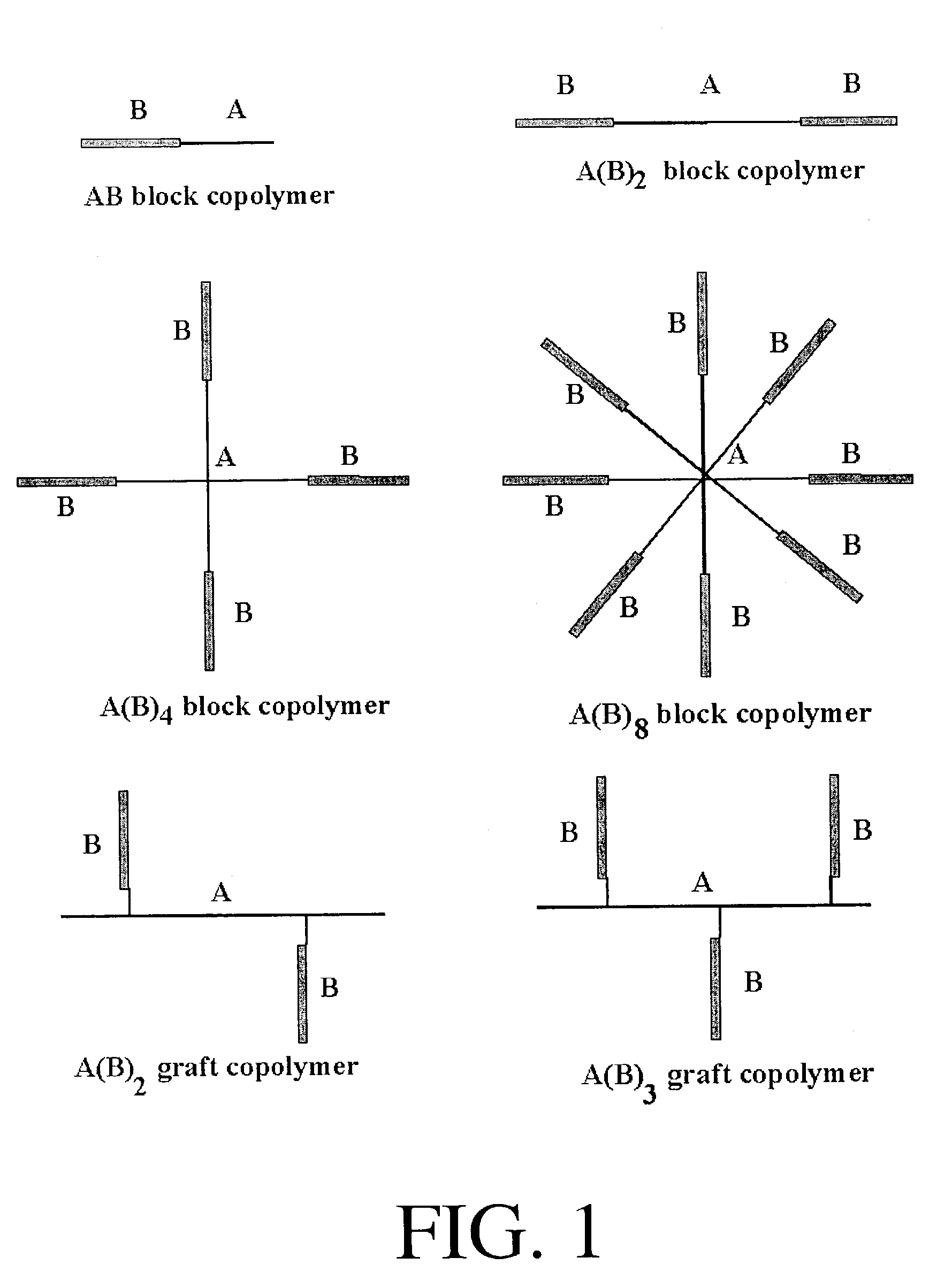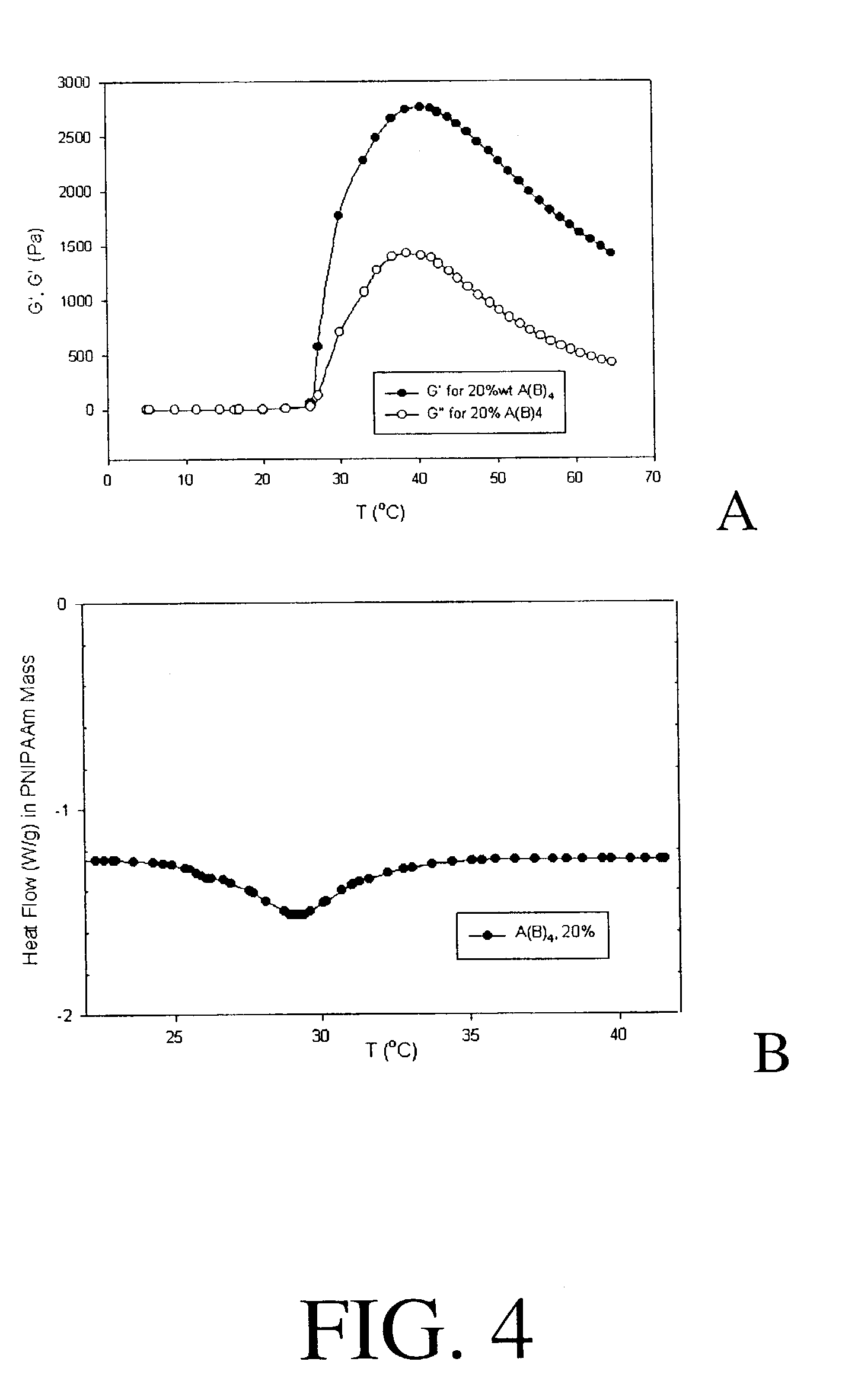Thermally reversible implant and filler
a polymer implant and filler technology, applied in the field of thermally reversible polymer implants and fillers, can solve the problems of difficult removal, few methods available, and the use of silicone implants and polymeric implants does not allow easy modification of shape, volume or placement in a reversible way, so as to achieve the effect of convenient removal
- Summary
- Abstract
- Description
- Claims
- Application Information
AI Technical Summary
Benefits of technology
Problems solved by technology
Method used
Image
Examples
example 1
Two-Armed Block Copolymer PNIPAAm-PEG-PNIPAAm
[0100]Linear polyethylene glycol (MW 5077) with terminal hydroxyl groups at both ends of the chain, HO(CH2CH2O)113H, was purchased from Shearwater Polymer (product name Sunbright DKH-50H, Lot. 68559) and used without further treatment. This reagent is herein referred to as the two-armed PEG.
[0101]The two-armed PEG (1.0 g ) was mixed with 1.35 g of purified NIPAAm, dissolved in water, then mixed with 2.0 ml of a 0.4 M Ce4+ solution, and 0.8 ml of 1N NaOH solution. The total mixture was 15 ml in volume. The reagents were cold mixed at 5° C. and sonicated to eliminate dissolved gas. The reaction was then allowed to proceed at 30° C. for 24 hours. At the end of 24 hours, the mixture was diluted to 100 ml by adding cold distilled water and placed in a 5° C. refrigerator to quench the reaction. The entire reaction was carried out under a helium blanket. The reaction vial was made of polypropylene instead of glass to avoid Ce4+ / OH-glass side rea...
example 2
Four Armed Block Copolymer PEG-(PNIPAAm)4
[0104]Four-arm branched polyethylene glycol (MW 10486) with one terminal hydroxyl group at each branch was purchased from Shearwater Polymer (product name Sunbright PTE10000, Lot. 76606) and used without further treatment. This reagent is herein referred to as the 4-armed PEG.
[0105]The four-armed PEG (1.0 g) was mixed with 1.35 g of purified NIPAAm, dissolved in water, then mixed with 2.0 ml of a 0.4 M Ce4+ solution, and 0.8 ml of 1N NaOH solution. The total mixture was 15 mL in volume. The reagents were cold mixed at 5° C. and sonicated to eliminate dissolved gas. The reaction was then allowed to proceed at 30° C. for 24 hours. At the end of 24 hours, the mixture was diluted to 100 ml by adding cold distilled water and placed in a 5° C. refrigerator to quench the reaction. The entire reaction was carried out under a helium blanket. The reaction vial was made of polypropylene instead of glass to avoid Ce4+ / OH-glass side reaction, which could...
example 3
Eight Armed Block Copolymer PEG-(PNIPAAm)8
[0108]Eight-arm branched polyethylene glycol (MW 19770) with a terminal hydroxyl group at each branch was purchased from Shearwater Polymer (product name Sunbright HGEO20000, Lot. 7D543) and used without further treatment. This reagent is herein referred to as the 8-armed PEG.
[0109]The eight-armed PEG (1.0 g) was mixed with 1.35 g of purified NIPAAm, dissolved in water, then mixed with 2.0 ml of a 0.4 M Ce4+ solution, and 0.8 ml of 1N NaOH solution. The total mixture was 15 mL in volume. The reagents were cold mixed at 5° C. and sonicated to eliminate dissolved gas. The reaction was then allowed to proceed at 30° C. for 24 hours. At the end of 24 hours, the mixture was diluted to 100 ml by adding cold distilled water and placed in a 5° C. refrigerator to quench the reaction. The entire reaction was carried out under a Helium blanket. The reaction vial was made of polypropylene instead of glass to avoid Ce4+ / OH-glass side reaction, which can...
PUM
| Property | Measurement | Unit |
|---|---|---|
| threshold temperature | aaaaa | aaaaa |
| mass ratios | aaaaa | aaaaa |
| temperature | aaaaa | aaaaa |
Abstract
Description
Claims
Application Information
 Login to View More
Login to View More - R&D
- Intellectual Property
- Life Sciences
- Materials
- Tech Scout
- Unparalleled Data Quality
- Higher Quality Content
- 60% Fewer Hallucinations
Browse by: Latest US Patents, China's latest patents, Technical Efficacy Thesaurus, Application Domain, Technology Topic, Popular Technical Reports.
© 2025 PatSnap. All rights reserved.Legal|Privacy policy|Modern Slavery Act Transparency Statement|Sitemap|About US| Contact US: help@patsnap.com



